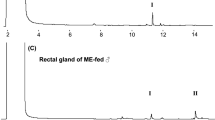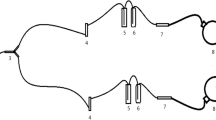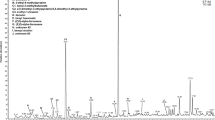Abstract
Bactrocera bryoniae is a polyphagous and economically significant fruit fly found in Indonesia, Papua New Guinea and Australia. To understand chemical-mediated sexual communication, and the potential for novel pheromone-based attractants for monitoring and mass-trapping of B. bryoniae, rectal gland exudates and emissions from sexually mature males and females were investigated. Gas chromatography–mass spectrometry showed that male rectal glands contained six compounds, of which 1,7-dioxaspiro[5,5]undecane elicited electroantennographic (EAD) and electropalpographic (EPD) responses in both sexes, ethyl 3-acetoxybutanoate elicited EPD responses in both sexes, N-(3-methylbutyl)acetamide elicited EAD response from males and 4-hydroxy-1,7-dioxaspiro[5.5]undecane elicited EAD responses in males and females and EPD responses in females. Female rectal glands contained 23 compounds with the esters ethyl laurate and ethyl myristate as major components. Amongst the female rectal gland constituents, ethyl laurate, ethyl myristate and ethyl palmitate elicited EAD responses in males and females, N-(3-methylbutyl)acetamide elicited EAD responses in males only, (E,E)-2,8-dimethyl-1,7-dioxaspiro[5.5]undecane elicited EAD responses in males and EPD responses in females, and 2,7-dimethyl-1,6-dioxaspiro[4.5]decane, (E,E)-2-ethyl-7-methyl-1,6-dioxaspiro[4.5]decane, (E,E)-2-ethyl-8-methyl-1,7-dioxaspiro[5.5]undecane, (Z,Z)-2,8-dimethyl-1,7-dioxaspiro[5.5]undecane, (E,E)-2-propyl-8-methyl-1,7-dioxaspiro[5.5]undecane and ethyl caprate elicited EPD responses in females only. Y-tube bioassays indicated that male rectal gland extracts and headspace volatiles attracted females and males, while female rectal gland extracts and headspace volatiles only attracted males. The results suggest that ethyl 3-acetoxybutanoate, 1,7-dioxaspiro[5,5]undecane and 4-hydroxy-1,7-dioxaspiro[5.5]undecane may be components of male-produced sex pheromone in B. bryoniae while (E,E)-2,8-dimethyl-1,7-dioxaspiro[5.5]undecane, N-(3-methylbutyl)acetamide, ethyl laurate, ethyl myristate and ethyl palmitate may be components of female-produced sex pheromone. Ethyl 3-acetoxybutanoate, N-(3-methylbutyl) acetamide, 1,7-dioxaspiro[5,5]undecane and 4-hydroxy-1,7-dioxaspiro[5.5]undecane may be components of male aggregation pheromone. These findings contribute to the understanding of pheromone communication in B. bryoniae and provide a foundation for developing pheromone-based monitoring and control methods.



Similar content being viewed by others
Availability of data and material
The authors confirm that data supporting the findings of this study are available within the manuscript and Online Resource
References
Baker R, Bacon AJ (1985) The identification of spiroacetals in the volatile secretions of two species of fruit fly (Dacus dorsalis, Dacus curcurbitae). Experientia 41:1484–1485. https://doi.org/10.1007/BF01950049
Baker R, Herbert RH, Parton AH (1982) Isolation and synthesis of 3- and 4-hydroxy-1,7-dioxaspiro[5.5]undecanes from the olive fly (Dacus oleae). J Chem Soc Chem Commun 1:7. https://doi.org/10.1039/c39820000601
Baker R, Herbert RH, Lomer RA (1982) Chemical components of the rectal gland secretions of male Dacus cucurbitae, the melon fly. Experientia 38:232–233. https://doi.org/10.1007/BF01945082
Baker R, Herbert RH, Grant GG (1985) Isolation and identification of the sex pheromone of the Mediterranean fruit fly, Ceratitis capitata (Wied). J Chem Soc Chem Commun 1:824–825
Bellas TE, Fletcher BS (1979) Identification of the major components in the secretion from the rectal pheromone glands of the Queensland fruit flies Dacus tryoni and Dacus neohumeralis (Diptera: Tephritidae). J Chem Ecol 5:795–803. https://doi.org/10.1007/BF00986564
Benelli G, Daane KM, Canale A et al (2014) Sexual communication and related behaviours in Tephritidae: current knowledge and potential applications for integrated pest management. J Pest Sci 87:385–405. https://doi.org/10.1007/s10340-014-0577-3
Booth YK, Schwartz BD, Fletcher MT et al (2006) A diverse suite of spiroacetals, including a novel branched representative, is released by female Bactrocera tryoni (Queensland fruit fly). Chem Commun. https://doi.org/10.1039/B611953K
Booth YK, Hayes PY, Moore CJ et al (2007) Synthesis and absolute configuration of a constitutionally-new [5.6] spiroacetal from B. tryoni (Queensland fruit fly). Org Biomol Chem 5:1111–1117. https://doi.org/10.1039/B701833A
Canale A, Germinara SG, Carpita A et al (2013) Behavioural and electrophysiological responses of the olive fruit fly, Bactrocera oleae (Rossi) (Diptera: Tephritidae), to male- and female-borne sex attractants. Chemoecology 23:155–164. https://doi.org/10.1007/s00049-013-0131-4
Canale A, Benelli G, Germinara GS et al (2015) Behavioural and electrophysiological responses to overlooked female pheromone components in the olive fruit fly, Bactrocera oleae (Diptera: Tephritidae). Chemoecology 25:147–157. https://doi.org/10.1007/s00049-014-0183-0
Carpita A, Canale A, Raffaelli A et al (2012) (Z)-9-tricosene identified in rectal gland extracts of Bactrocera oleae males: first evidence of a male-produced female attractant in olive fruit fly. Naturwissenschaften 99:77–81. https://doi.org/10.1007/s00114-011-0868-y
Clarke AR, Powell KS, Weldon CW, Taylor PW (2011) The ecology of Bactrocera tryoni (Diptera: Tephritidae): what do we know to assist pest management? Ann Appl Biol 158:26–54. https://doi.org/10.1111/j.1744-7348.2010.00448.x
Cruz-López L, Malo EA, Rojas JC (2015) Sex pheromone of Anastrepha striata. J Chem Ecol 41:458–464. https://doi.org/10.1007/s10886-015-0581-y
Dominiak BC, Ekman JH (2013) The rise and demise of control options for fruit fly in Australia. Crop Prot 51:57–67. https://doi.org/10.1016/j.cropro.2013.04.006
Dominiak BC, Mapson R (2017) Revised distribution of Bactrocera tryoni in eastern Australia and effect on possible incursions of Mediterranean fruit fly: development of Australia’s eastern trading block. J Econ Entomol 110:2459–2465. https://doi.org/10.1093/jee/tox237
Doorenweerd C, Leblanc L, Norrbom AL et al (2018) A global checklist of the 932 fruit fly species in the tribe Dacini (Diptera, Tephritidae). Zookeys 730:19–56. https://doi.org/10.3897/zookeys.730.21786
Drew RAI, Romig MC (2013) Tropical Fruit Flies of South-East Asia. CAB International, Wallingford
El-Sayed AM (2007) The pherobase: database of pheromones and semiochemicals. http://www.pherobase.com/. (Accessed 17 Mar 2019)
El-Sayed AM, Byers JA, Manning LM et al (2008) Floral scent of Canada thistle and its potential as a generic insect attractant. J Econ Entomol 101:720–727. https://doi.org/10.1093/jee/101.3.720
El-Sayed AM, Venkatesham U, Unelius CR et al (2019) Chemical composition of the rectal gland and volatiles released by female Queensland fruit fly, Bactrocera tryoni (Diptera: Tephritidae). Environ Entomol. https://doi.org/10.1093/ee/nvz061
Ero MM, Hamacek E, Clarke AR (2011) Foraging behaviours of Diachasmimorpha kraussii (Fullaway) (Hymenoptera: Braconidae) and its host Bactrocera tryoni (Froggatt) (Diptera: Tephritidae) in a nectarine (Prunus persica (L.) Batsch var. nectarina (Aiton) Maxim) orch. Aust J Entomol 5:9. https://doi.org/10.1111/j.1440-6055.2011.00821.x
Fletcher BS (1968) Storage and release of sex pheromone by the Queensland fruit fly, Dacus tryoni (Diptera:Trypetidae). Nature 219:631–632. https://doi.org/10.1038/219631a0
Fletcher BS (1969) The structure and function of the sex pheromone glands of the male Queensland fruit fly, Dacus tryoni. J Insect Physiol 15:1309–1322. https://doi.org/10.1016/0022-1910(69)90193-0
Fletcher MT, Kitching W (1995) Chemistry of fruit flies. Chem Rev 95:789–828. https://doi.org/10.1021/cr00036a001
Fletcher MT, Wells JA, Jacobs MF et al (1992) Chemistry of fruit-flies. Spiroacetal-rich secretions in several Bactrocera species from the South-West Pacific region. J Chem Soc Perkin Trans 1:2827–2831. https://doi.org/10.1039/P19920002827
Haniotakis GE (1974) Sexual attraction in the olive fruit fly, Dacus oleae (Gmelin). Environ Entomol 3:82–86. https://doi.org/10.1093/ee/3.1.82
Haniotakis GE, Mazomenos BE, Tumlinson JH (1977) A sex attractant of the olive fruit fly, Dacus oleae and its biological activity under laboratory and field conditions. Entomol Exp Appl 21:81–87. https://doi.org/10.1111/j.1570-7458.1977.tb02660.x
Haniotakis G, Francke W, Mori K et al (1986) Sex-specific activity of (R)-(−)- and (S)- (+)-1,7-dioxaspiro[5.5]undecane, the major pheromone of Dacus oleae. J Chem Ecol 12:1559–1568. https://doi.org/10.1007/BF01012372
Hayes P, Fletcher MT, Moore CJ, Kitching W (2001) Synthesis and absolute stereochemistry of a constitutionally new spiroacetal from an insect. J Org Chem 66:2530–2533. https://doi.org/10.1021/jo015502p
Heath RR, Landolt PJ, Robacker DC et al (2000) Sexual pheromones of tephritid flies: clues to unravel phylogeny and behavior. In: Norrbom AL (ed) Aluja M. Phylogeny and Evolution of Behavior. CRC Press, Fruit Flies (Tephritidae), pp 793–809
Hendrichs J, Robinson AS, Cayol JP, Enkerlin W (2002) Medfly areawide sterile insect technique programmes for prevention, suppression or eradication: the importance of mating behavior studies. Fla Entomol 85:1–14. https://doi.org/10.1653/0015-4040(2002)085[0001:MASITP]2.0.CO;2
Hickey P, Woods B, Windle B et al (2010) National fruit fly strategy implementation action plan. Plant Health Australia, Canberra, Australia
Kitching W, Lewis JA, Fletcher MT et al (1986) Spiroacetals in rectal gland secretions of Australasian fruit fly species. J Chem Soc Chem Commun 11:853. https://doi.org/10.1039/c39860000853
Kitching W, Lewis JA, Perkins MV et al (1989) Chemistry of fruit flies. Composition of the rectal gland secretion of (male) Dacus cucumis (cucumber fly) and Dacus halfordiae. Characterization of (Z, Z)-2,8-dimethyl-1,7-dioxaspiro[5.5]undecane. J Org Chem 54:3893–3902. https://doi.org/10.1021/jo00277a028
Krohn S, Fletcher MT, Kitching W et al (1991) Chemistry of fruit flies: Nature of glandular secretion and volatile emission of Bactrocera (bactrocera) cacuminatus (Héring). J Chem Ecol 17:485–495. https://doi.org/10.1007/BF00994347
Lauzon CR, Potter SE (2012) Description of the irradiated and nonirradiated midgut of Ceratitis capitata Wiedemann (Diptera: Tephritidae) and Anastrepha ludens Loew (Diptera: Tephritidae) used for sterile insect technique. J Pest Sci 85:217–226. https://doi.org/10.1007/s10340-011-0410-1
Leblanc L, Tora E, Drew RAI, Allwood AJ (2013) Host plant records for fruit flies (Diptera: Tephritidae: Dacini) in the Pacific Islands. Proc Hawaiian Entomol Soc 44:11–53. https://doi.org/10.1002/ana.21927.Dicer
Levi-zada A, Levy A, Rempoulakis P et al (2020) Diel rhythm of volatile emissions of males and females of the peach fruit fly Bactrocera zonata. J Insect Physiol 120:103970. https://doi.org/10.1016/j.jinsphys.2019.103970
Mazomenos BE, Haniotakis GE (1981) A multicomponent female sex pheromone of Dacus oleae Gmelin: Isolation and bioassay. J Chem Ecol 7:437–444. https://doi.org/10.1007/BF00995766
Mazomenos BE, Haniotakis GE (1985) Male olive fruit fly attraction to synthetic sex pheromone components in laboratory and field tests. J Chem Ecol 11:397–405. https://doi.org/10.1007/BF01411425
Mitchell RF, Curkovic T, Mongold-Diers JA et al (2017) Evidence that cerambycid beetles mimic vespid wasps in odor as well as appearance. J Chem Ecol 43:75–83. https://doi.org/10.1007/s10886-016-0800-1
Nation JL (1972) Courtship behavior and evidence for a sex attractant in the male Caribbean fruit fly, Anastrepha suspensa. Ann Entomol Soc Am 65:1364–1367. https://doi.org/10.1093/aesa/65.6.1364
Nation JL (1990) Biology of pheromone release by male Caribbean fruit flies, Anastrepha suspensa (Diptera: Tephritidae). J Chem Ecol 16:553–572. https://doi.org/10.1007/BF01021786
Nishida R, Tan KH, Fukami H (1988) Cis-3,4-dimethoxycinnamyl alcohol from the rectal glands of male oriental fruit fly, Dacus dorsalis. Chem Express 3:207–210
Nishida R, Tan KH, Serit M et al (1988) Accumulation of phenylpropanoids in the rectal glands of males of the Oriental fruit fly, Dacus dorsalis. Experientia 44:534–536. https://doi.org/10.1007/BF01958941
Noushini S, Perez J, Park SJ et al (2019) Rectal gland chemistry, volatile emissions, and antennal responses of male and female banana fruit fly. Bactrocera musae Insects 11:32. https://doi.org/10.3390/INSECTS11010032
Oh H, Jeong SA, Kim J, Park KC (2019) Morphological and functional heterogeneity in olfactory perception between antennae and maxillary palps in the pumpkin fruit fly Bactrocera depressa. Arch Insect Biochem Physiol. https://doi.org/10.1002/arch.21560
Perdomo AJ, Nation JL, Baranowski RM (1976) Attraction of female and male Caribbean fruit flies to food-B\baited and male-baited traps under field conditions. Environ Entomol 5:1208–1210. https://doi.org/10.1093/ee/5.6.1208
Perkins MV (1990) Characterisation and synthesis of Bactrocera fruit fly pheromones. The University of Queensland, Australia Department of Chemistry, Australia
Perkins MV, Fletcher MT, Kitching W et al (1990) Chemical studies of rectal gland secretions of some species of Bactrocera dorsalis complex of fruit flies (diptera: Tephritidae). J Chem Ecol 16:2475–2487. https://doi.org/10.1007/BF01017470
Perkins MV, Kitching W, Drew RAI et al (1990) Chemistry of fruit flies: composition of the male rectal gland secretions of some species of South-East Asian Dacinae. Re-examination of Dacus cucurbitae (melon fly). J Chem Soc Perkin Trans 1:1111–1117. https://doi.org/10.1039/P19900001111
Piccardi P (1980) Insect sex-communication and prospects for pheromones in pest management. Bolletino Zool 47:397–408. https://doi.org/10.1080/11250008009438696
Schutze M, McMahon J, Krosch M et al (2018) The Australian Handbook for the Identification of Fruit Flies. Plant Health Australia, Canberra, ACT
Schwartz BD, Moore CJ, Rahm F et al (2008) Spiroacetal biosynthesis in insects from Diptera to Hymenoptera: The giant ichneumon wasp Megarhyssa nortoni nortoni Cresson. J Am Chem Soc 130:14853–14860. https://doi.org/10.1021/ja8036433
Sivinski JM, Calkins C (1986) Use of pheromones in tropical crops: pheromones and parapheromones in the control of tephritids. Florida Entomol 69:157–168. https://doi.org/10.2307/3494757
Sivinski J, Aluja M, Dodson GN et al (2000) Topics in the evolution of sexual behavior in the Tephritidae. In: Norrbom AL (ed) Aluja M. Phylogeny and Evolution of Behavior. CRC Press, Fruit Flies (Tephritidae), pp 751–792
Symonds MRE, Moussalli A, Elgar MA (2009) The evolution of sex pheromones in an ecologically diverse genus of flies. Biol J Linn Soc 97:594–603
Tokushima I, Orankanok W, Tan KH et al (2010) Accumulation of phenylpropanoid and sesquiterpenoid volatiles in male rectal pheromonal glands of the guava fruit fly, Bactrocera correcta. J Chem Ecol 36:1327–1334. https://doi.org/10.1007/s10886-010-9874-3
Verschut TA, Farnier K, Cunningham JP, Carlsson MA (2018) Behavioral and physiological evidence for palp detection of the male-specific attractant cuelure in the Queensland fruit fly (Bactrocera tryoni). Front Physiol. https://doi.org/10.3389/fphys.2018.00990
Vijaysegaran S (1997) Fruit fly research and development in tropical Asia. In: Allwood A, Drew RE (eds) Management of Fruit Flies in the Pacific. Australian Centre for International Agricultural Research Proceedings, Canberra
Wee SL, Tan KH (2005) Female sexual response to male rectal volatile constituents in the fruit fly, Bactrocera carambolae (Diptera: Tephritidae). Appl Entomol Zool 40:365–372. https://doi.org/10.1303/aez.2005.365
Zamek AL, Spinner JE, Micallef JL et al (2012) Parasitoids of Queensland fruit fly Bactrocera tryoni in Australia and prospects for improved biological control. Insects 3:1056–1083
Zhang X, Wei C, Miao J et al (2019) Chemical compounds from female and male rectal pheromone glands of the guava fruit fly Bactrocera correcta. Insects. https://doi.org/10.3390/insects10030078
Zheng L-Y, Sun G-M, Liu Y-G et al (2012) Aroma volatile compounds from two fresh pineapple varieties in China. Int J Mol Sci 13:7383–7392. https://doi.org/10.3390/ijms13067383
Acknowledgements
We are grateful to the Queensland Department of Agriculture and Fisheries (QDAF), especially Sybilla Oczkowicz for providing B. bryoniae for this research.
Funding
This research was funded by Australian Research Council Industrial Transformation Training Centre (ITTC) for Fruit Fly Biosecurity Innovation (Project IC50100026), funded by the Australian Government.
Author information
Authors and Affiliations
Contributions
S.N., P.T., J.J., I.J., designed the experiment. S.N. and S.J.P. performed the experiments. S.N. analysed the data and wrote the original draft. P.T., J.J., I.J. and S.J.P reviewed and edited the manuscript. All authors read and approved the final manuscript.
Corresponding author
Ethics declarations
Conflict of interest
The authors declare that they have no conflict of interest.
Additional information
Communicated by Marko Rohlfs.
Electronic supplementary material
Below is the link to the electronic supplementary material.
Rights and permissions
About this article
Cite this article
Noushini, S., Park, S.J., Jamie, I. et al. Rectal gland exudates and emissions of Bactrocera bryoniae: chemical identification, electrophysiological and pheromonal functions. Chemoecology 31, 137–148 (2021). https://doi.org/10.1007/s00049-020-00335-z
Received:
Accepted:
Published:
Issue Date:
DOI: https://doi.org/10.1007/s00049-020-00335-z




